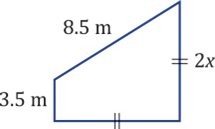What is the gradient of the line joining the points (1,1) and (5,5)?
1
How many mm in 5.85m ?
5850 mm
Simplify 7a2b3 x 10ab
70a3b4
What is the rule for a horizontal line passing through the point (–5, 9)?
y = 9
A cube has a side length of 4cm. What is its total surface area?
1 side = 4x4 = 24cm2
6 sides x 24 cm2 = 144cm2
317 x 3-16 is equal to:
A) 0
B) 1
C) 3
D) 9
E) 1.798 x 10-16
Since 317 x 3-16 = 317 + (-16) = 317-16 = 31 = 3
C) 3
Which of the following points does not lie on the line y + x = 7 ?
A: (3, 4)
B: (6, 1)
C: (1, 6)
D: (-2, 5)
D: (-2, 5)
The calculation 0.5 x πr2 would be used to calculate:
A) area of a circle
B) circumference of a circle
C) area of a semi-circle
D) surface area of a cylinder
C) area of a semi-circle
Expand and simplify (2a4b-2c3)2 and express your answer using only positive indices.
Expanded = 22a4x2b-2x2c3x2 = 4a8b-4c6
With only positive indices = 4a8c6/b4
The line 3y - 6x = 6 converted to gradient-intercept form is y = ___x + ___
3y = 6x + 6
Divide by 3
y = 2x + 2
A rectangle has a length of x metres and a width of 5 metres. What is the expression for calculating its area?
A) 2x + 10
B) 5x
C) 2x
D) x + 5
B) 5x
Since area = length x width = 5x
The population of the world is estimated to be 8.185 billion people as of this morning.
Write that number in scientific notation.
8.185 billion = 8,185,000,000
In scientific notation = 8.185 x 109
What is the rule for a line which passes through the origin and has a gradient of -2?
y = -2x
(Since passing through origin gives y-intercept of 0!)
A circle has an area of 64π cm2.
What would be its circumference, to the nearest whole cm?
Hint: You must first use the area above to find the radius of the circle.
Area = π x r2
So area of 64π = π x 82
So radius = 8cm
Circumference = 2 x π x r
= 2 x π x 8 = 50.27cm = 50cm
A) -6
B) -5
C) -1
D) 0
E) 1
-(5x)0 + (-5x)0 - 5x0
= -(1) + (1) - 5(1)
= -1 + 1 - 5 = -5
B) -5
What is the equation of the line passing through the coordinates (2,2) and (6, 10)?
y = mx + c
Step 1: Find gradient
m = rise/run = 8/4 = 2
so now y = 2x + c
Step 2: substitute in a coordinate to find c
using coordinate (6, 10) gives
10 = 2(6) + c
10 = 12 + c
10-12 = c
-2 = c
So equation is y = 2x - 2
If the perimeter of the following shape was 28cm, then x would be?
28 - 12 = 4x
16 = 4x
So x = 4cm
If 22y = 32, then y = ?
25 = 32
So 5 = 2y
So 5/2 = 2.5 = y